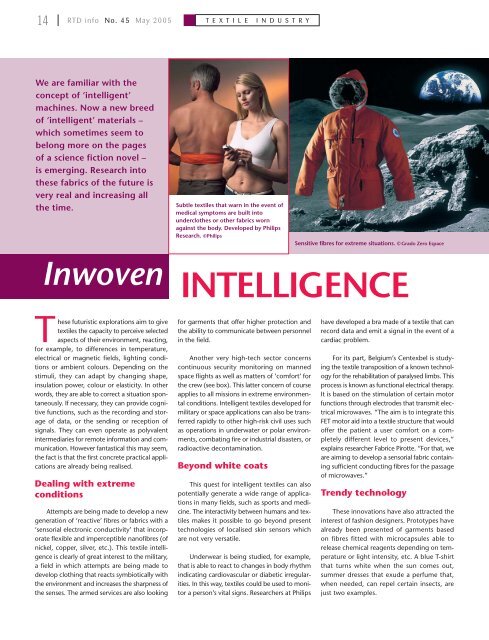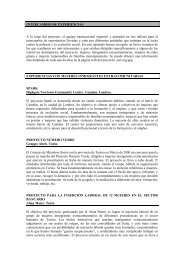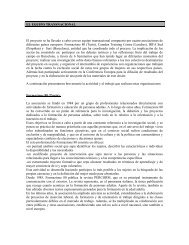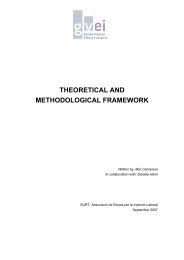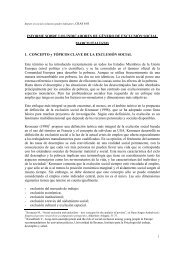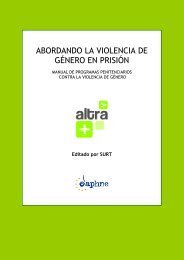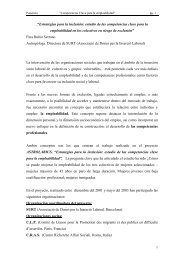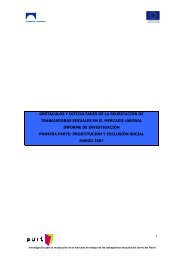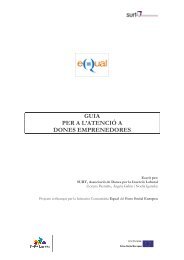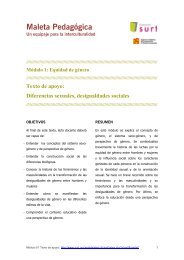RTD info MAYO 2005 - Surt
RTD info MAYO 2005 - Surt
RTD info MAYO 2005 - Surt
Create successful ePaper yourself
Turn your PDF publications into a flip-book with our unique Google optimized e-Paper software.
14<strong>RTD</strong> <strong>info</strong> No. 45 May <strong>2005</strong>T E X T I L E I N D U S T R YWe are familiar with theconcept of ‘intelligent’machines. Now a new breedof ‘intelligent’ materials –which sometimes seem tobelong more on the pagesof a science fiction novel –is emerging. Research intothese fabrics of the future isvery real and increasing allthe time.Subtle textiles that warn in the event ofmedical symptoms are built intounderclothes or other fabrics wornagainst the body. Developed by PhilipsResearch. ©PhilipsSensitive fibres for extreme situations. © Grado Zero EspaceInwoven INTELLIGENCEThese futuristic explorations aim to givetextiles the capacity to perceive selectedaspects of their environment, reacting,for example, to differences in temperature,electrical or magnetic fields, lighting conditionsor ambient colours. Depending on thestimuli, they can adapt by changing shape,insulation power, colour or elasticity. In otherwords, they are able to correct a situation spontaneously.If necessary, they can provide cognitivefunctions, such as the recording and storageof data, or the sending or reception ofsignals. They can even operate as polyvalentintermediaries for remote <strong>info</strong>rmation and communication.However fantastical this may seem,the fact is that the first concrete practical applicationsare already being realised.Dealing with extremeconditionsAttempts are being made to develop a newgeneration of ‘reactive’ fibres or fabrics with a‘sensorial electronic conductivity’ that incorporateflexible and imperceptible nanofibres (ofnickel, copper, silver, etc.). This textile intelligenceis clearly of great interest to the military,a field in which attempts are being made todevelop clothing that reacts symbiotically withthe environment and increases the sharpness ofthe senses. The armed services are also lookingfor garments that offer higher protection andthe ability to communicate between personnelin the field.Another very high-tech sector concernscontinuous security monitoring on mannedspace flights as well as matters of ‘comfort’ forthe crew (see box). This latter concern of courseapplies to all missions in extreme environmentalconditions. Intelligent textiles developed formilitary or space applications can also be transferredrapidly to other high-risk civil uses suchas operations in underwater or polar environments,combating fire or industrial disasters, orradioactive decontamination.Beyond white coatsThis quest for intelligent textiles can alsopotentially generate a wide range of applicationsin many fields, such as sports and medicine.The interactivity between humans and textilesmakes it possible to go beyond presenttechnologies of localised skin sensors whichare not very versatile.Underwear is being studied, for example,that is able to react to changes in body rhythmindicating cardiovascular or diabetic irregularities.In this way, textiles could be used to monitora person’s vital signs. Researchers at Philipshave developed a bra made of a textile that canrecord data and emit a signal in the event of acardiac problem.For its part, Belgium’s Centexbel is studyingthe textile transposition of a known technologyfor the rehabilitation of paralysed limbs. Thisprocess is known as functional electrical therapy.It is based on the stimulation of certain motorfunctions through electrodes that transmit electricalmicrowaves. “The aim is to integrate thisFET motor aid into a textile structure that wouldoffer the patient a user comfort on a completelydifferent level to present devices,”explains researcher Fabrice Pirotte. “For that, weare aiming to develop a sensorial fabric containingsufficient conducting fibres for the passageof microwaves.”Trendy technologyThese innovations have also attracted theinterest of fashion designers. Prototypes havealready been presented of garments basedon fibres fitted with microcapsules able torelease chemical reagents depending on temperatureor light intensity, etc. A blue T-shirtthat turns white when the sun comes out,summer dresses that exude a perfume that,when needed, can repel certain insects, arejust two examples.


